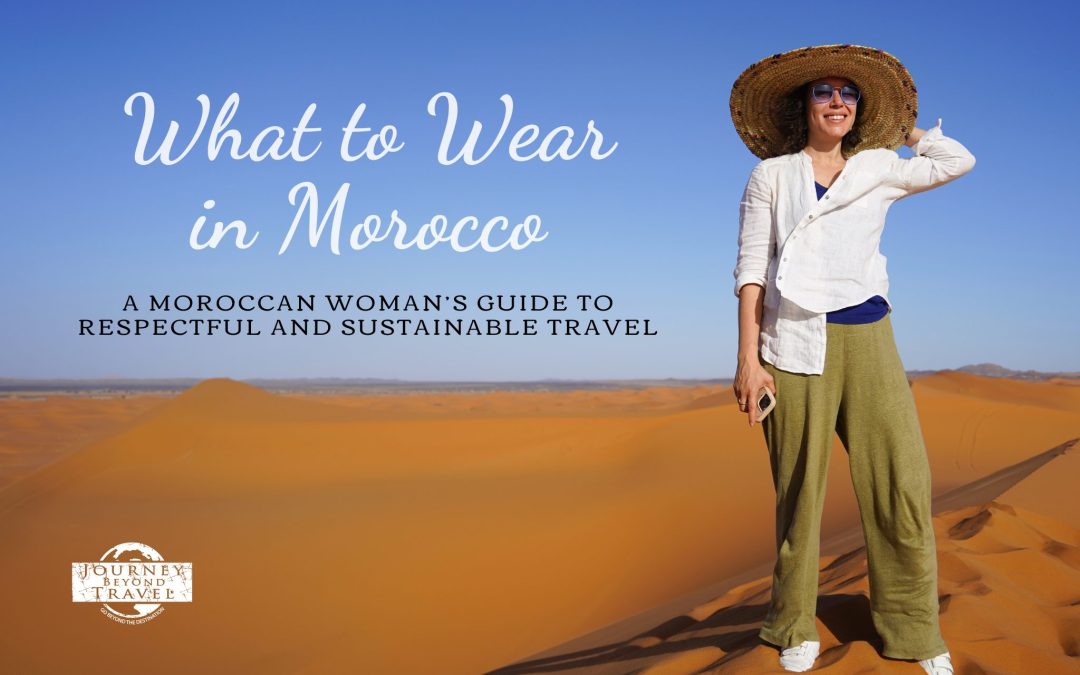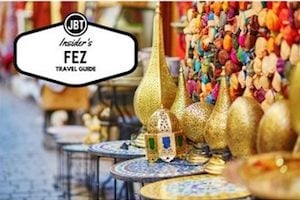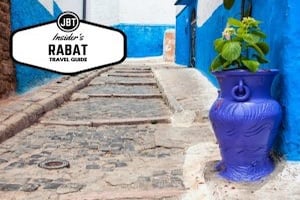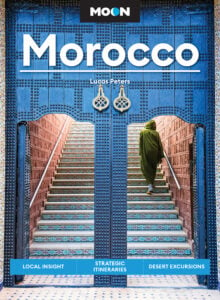What should I wear?” – I often get this question from travelers coming to Morocco, particularly women, wondering what to wear in Morocco. While the country does not have a dress code, it is always a good thing to understand the culture before packing your suitcase.
Whenever travelers ask me that question, I can’t help but smile. I grew up in Tangier in the 80s and still remember walking for 20 minutes to the beach in my swimsuit (only), towel in hand, ready for a sunny day. On the sand, people were wearing everything from traditional jellabas (long hooded tunics) to large, flowing robes, to bikinis, shorts and other swimwear. It was a colorful mix, relaxed yet entirely unique.
Today, the scene has changed a little, but Morocco remains a fairly liberal Muslim country with no strict dress code. Religion, of course, has always been highly present in people’s daily lives here. Over the past couple of decades, men have become somewhat more verbally aggressive with catcalling and snarky comments, while women have increasingly chosen more conservative clothing — partly to deter unwanted attention.
That said, respecting Moroccan traditions and local customs is key if you want to travel respectfully, avoid disapproving looks, and truly connect with people, especially in smaller towns, villages, or rural areas. As a general rule of thumb, the rural regions are much more conservative in spirit and dress than the cities — probably just like where you’re from! You can check out our blog post about what is appropriate to wear in smaller villages and in the Sahara desert.
I know this post is mostly geared to women as there are no specific clothing requirements for men from a cultural standpoint. All genders could use the information here to help make those often-daunting packing decisions. A few places might have dress codes where you would need to wear pants or dressy shoes, so if you’re making a reservation at some place that seems a bit more upscale, do check.
Now, let me give you a run down of Morocco’s seasons and then the real scoop — what I would actually pack if I were traveling here now.
Oh, and as a little bonus for you, I’ve included at the end of this post a list of some of my favorite places to shop for clothes and accessories in Morocco.
Seasons in Morocco
With climate change, it is hard to really predict the weather nowadays. Following is a brief overview of what you’d likely be looking at.
Spring: Overall, spring in Morocco is great for traveling. Some regions can be a little tricky. At the worst, Chefchaouen, for instance, might be cool and rainy (so like 55ºF with a drizzle) while if there is a heat wave, the Sahara might see day time highs over 110ºF. You can expect generally nice early summer type of weather with warm days and cooler evenings.
Summer: Summer in Morocco is hot, especially inland, in the southern regions and in the desert. Daytime highs can easily reach 100-110ºF in Marrakesh or over 115ºF in the Sahara, while coastal cities like Essaouira and Tangier stay milder, around 75–85ºF, with a refreshing breeze. Evenings generally cool down a bit, and sometimes temperatures do drop at night in the desert regions. Keep in mind that summer is also dry, so the sun can feel intense and you can easily get sunburns.
Fall: Fall is one of the nicest times to visit. Temperatures begin to moderate after the scorching summer, with inland highs around 80-90ºF and cooler nights, sometimes dipping into the 60sºF. Coastal areas remain pleasant and breezy, and the beaches feel just right for a dip. Rain is still limited in most regions, but the Atlas Mountains may start seeing occasional showers as the season progresses. Overall, it’s generally warm, comfortable, with occasional showers and ideal for exploring.
Winter: Winter in Morocco is mild on the coast and in the cities, with daytime highs around 55-65ºF in Marrakech or Casablanca, but nights can get chilly, sometimes down to the 40sºF. The Atlas Mountains see snow, making it perfect for skiing or hiking with a crisp, cold air. Desert nights can also get surprisingly cold, sometimes near freezing. Rainfall is more frequent in northern and coastal regions, while the south stays mostly dry.

General Clothing Tip
If you’re into doing good and leaving a positive footprint on this world, then choosing natural fabrics like linen, organic cotton, or merino (and second-hand items — but that may be a story for another post) not only keeps you comfortable but also supports more sustainable travel. Depending on your style, you can pack different colors or stick to neutrals that can be easier to mix and match.
You don’t need to bring too much with you either. Morocco is full of artisans and small indie boutiques where you can find some beautiful handmade pieces that cater to locals and travelers alike. Cities like Fez, Marrakesh, Tangier and Essaouira abound with unique shops. Shopping locally supports the economy, helps preserve traditional crafts, and introduces you to unique items you’ll actually want to wear again back home.
Tops
Spring & Summer: Lightweight and light colored cotton or linen shirts and blouses are perfect. I would throw in merino in there! Breathable fabrics keep you cool, and long sleeves protect against the sun. Loose-fitting tunics or peasant-style tops are also great for layering and staying modest without feeling stifled. You can also wear sleeveless tops, round or v-necks won’t matter as long as they’re not too plunging or revealing. If possible, avoid spaghetti straps (unless you’re going out in the evening) even if most people won’t mind it. Sleeveless can be fine if you keep a scarf around (see my note on scarves below). My personal favorite is a button up linen blouse to mix and match with tank tops or T-shirts. In the cover photo of this post, I’m wearing these in the desert in June. Check out that super-wide rim hat!
Fall & Winter: Switch to long-sleeved tops in slightly heavier cotton, wool-blend sweaters, or thin merino layers. These are great for layering under fleece, hoodies or jackets when exploring mountain towns or cooler cities like Chefchaouen. You will always have the option of rolling your sleeves up if you feel too warm.
The days will likely range from 40°F to 85°F, so you’ll want to have light layers that you can adjust as needed. If you’re fair-skinned or sensitive to strong sun, consider packing a light long-sleeve layer for your arms and legs, especially for the Sahara and the mountains where the sun can be intense.
For tops, I prefer to have the a white linen button-up blouse and a couple of light-colored shirts or tanks. Linen is great for the weather and is breathable, but it does get wrinkly. That’s when you bust out that life-hack of hanging your linen clothes in the bathroom as you take a shower… or your Riad host would happily iron them out for you.
Dresses & Skirts
Spring & Summer: Midi or maxi dresses are my go-to. They’re airy, comfortable, modest, and protect you from the harsh sun. They’re really great for wandering through medinas or sitting at a café. I love wrap dresses or flowy skirts in light fabrics because they move beautifully with you and look effortlessly stylish. Mid- to high-knee skirts or dresses are also great options. Just avoid extremely short or tight pieces, especially outside urban tourist areas. I always pack one solid-color dress that I can easily dress up for a nice dinner or down for a daytime stroll, and a button-down dress or skirt that I can open or close depending on whether I’m by the pool, exploring, or simply lounging.
Fall & Winter: Midi and maxi skirts in wool blends or heavier cotton, paired with tights or leggings, are perfect for staying warm while exploring. Long-sleeved dresses or sweater dresses layered with scarves create a chic, cozy look for city sightseeing or evening dinners. I like to have versatile pieces that I can layer or accessorize depending on the temperature and occasion. One simple dress can be paired with boots and a scarf for daytime, or with jewelry and a tailored coat for dinner.
Shirt dresses, light tunics, and kimonos are another great alternative to conservative-yet-comfy wear in Morocco. Make sure they are long enough to cover your bottom, or thighs. You can wear them with leggings, or tie a belt around to turn them into dresses on occasion. These are things you can also buy as you walk around the medinas. Bazaars and traditional clothing shops abound with Moroccan-style tunics outlined with beautiful embroidery and sfifa, a handmade ribbon braid.
Pants & Bottoms
Spring & Summer: Linen or cotton and wide-leg pants, or culottes are perfect for city strolls and desert trips. Light-colored pants reflect the sun and stay cool. For shorts, definitely not Daisy Dukes! The kind of shorts I’m referring to here are more the mid-thigh Safari kind. Tight shorts worn with a long shirt can also be a sensible option for working out or going out for a jog.
Fall & Winter: If you’re heading to colder regions, swap for heavier fabrics like denim, wool-blend pants, or even corduroys if you have space in your luggage (they do weigh). While denim jeans may get too sticky and warm in the summer and spring, they do make a versatile garment that you can dress up or down as you’re traveling during the slightly cooler months. Leggings are great for layering underneath, or wearing with a long tunic.
If you wear skinny pants, do make sure to cover up your bottom if you will be visiting villages and popular neighborhoods, or invited over for a family meal.
Swimwear
Spring & Summer: Swimsuits, bikinis, or tankinis are all fine at beaches and hotel pools. In private spaces, you’ll see everything from modest to revealing swimwear. Morocco is fairly liberal in tourist areas, but keep in mind that modest swimwear is appreciated if you’re at public beaches or pools outside major tourist spots. A lightweight cover-up or kaftan is perfect for walking to the beach or lounging at a riad pool. I would definitely recommend avoiding string bikinis or going topless anywhere here in Morocco.
Fall & Winter: Swimming is less common (and can be a bit challenging!) during these cooler months, but if you plan to visit heated pools or spa resorts, a swimsuit is still handy. Bring a warm cover-up or robe for walking between indoor and outdoor areas, and don’t forget sandals or flip-flops for the poolside.
At the beach or poolside, if you need a cover-up, consider buying a locally made kaftan, tunic or multi-purpose scarf that you can use as a sarong (more on scarves below). It’s pretty stylish, respectful, and helps support artisans.
For the ladies, be sure to bring a bikini for the hammam — though you’ll only need the bottom piece. The scrubbing expert will move it around a bit during the treatment, and in many spas, disposable underwear is also provided.
Jackets
Spring & Summer: In spring, it is a good idea to pack a light jacket for the occasional rain shower, chilly early-morning hike or late-evening camp fire in the desert. My favorite for travel is something like this waterproof windbreaker and rain jacket.
Fall & Winter: It does get cold in the winter, so maybe also pack a hoodie, a rain jacket and a couple sweaters and a warm coat.
A fleece top is almost essential in the mountains, and a no matter what time of the year.
Shoe-Wear
What to wear in Morocco for your feet? Well… you will probably do a lot of walking. You will need a good, comfy pair of walking shoes. My favorite pick are ones like these. You can bring sandals too. Closed-toe sandals are best. The feeling of tiny sand digging between your toes isn’t that agreeable. These will also protect your toes from any hazards. In many spots, the streets and sidewalks are uneven. That said, you will also want to have something like these sandals or flip-flops with you as well when you head to the hammam, swimming pool and the beach!
Spring & Summer: There will be a lot of walking in the medinas! Comfortable sandals, supportive flats, or good walking shoes are a must for wandering around. Breathable sneakers are generally good for longer walks or desert excursions. Flip-flops are fine at beaches or riads, but leave them off for city exploration as some roads can be uneven and pretty dusty.
Fall & Winter: Closed-toe shoes or ankle boots with good traction are essential. Waterproof options help in rainy months, especially in northern Morocco. A pair of lightweight hiking shoes is perfect for mountains or desert terrain. Although if you’re not doing any heavy-duty hikes, you can just pack your comfy sneakers.
If you’re packing light, a good pair of comfy walking or active shoes and a pair of light sandals can be all you need.
If you’re in the southern parts of Morocco, do make sure to check out artisans that makes raffia shoes. They’re light, breathable and a really good example of modern Moroccan craftsmanship. I’ve included my favorite shops below. Many great leather shoes are also handmade in Morocco. You’ll love the styles and colors!
Buying directly from local shoemakers not only gives you a unique piece but also keeps your travel footprint (pun intended!) lighter by supporting sustainable, handmade goods.
Accessories
Glasses: Sunglasses are essential year-round, especially in the desert.
Jewelry: Keep it simple, especially if you’re planning on shopping around. You probably want to leave the precious jewels at home. A wedding ring and a few regulars, one or two necklaces, and 2 or 3 pairs of earrings is what I generally travel with. Morocco is particularly known for its beautiful silver jewelry, especially from places like Tiznit. You’d be able to find some beautiful pieces. Just make sure you have the shop owners test the metal for you to make sure you’re actually getting silver and not a regular metal.
Bags: Crossbody bags and day bags (or backpacks) are practical for cities and markets; a tote works for beaches and excursions. Ideally your bag will have some room to stuff a few souvenirs.
If you’re low waste like me, pack up a lightweight reusable grocery bag (foldable or easy to fold) like this one, and a couple of reusable produce bags for when you get those dates or delicious fruits from the souk. Otherwise, just grab one of the woven palm straw bags from any store in Morocco. We call them qouffa (qoo-ffa). They come in all shapes and sizes.
Hats: Wide-brimmed hats protect from the sun in summer, while a cozy beanie works in winter. Morocco is known for reed hats, like the sheshia in the north. You’ll be able to grab one from an artisan shop in the medina. Everywhere around you can find a more plain version of the sheshia. Riads and some rooftop restaurants often offer these to their guests while they are in the rooftop basking in the sun, a fresh-squeezed juice at hand. And if you head to the Blue City of Chefchaouen, check out the Hat Man shop for some funky style knit hats. You will find a colorful collection of fun hats for all tastes and all ages.
Scarves: In Morocco, covering the head with a scarf is not mandatory. You will see women with headscarves and women without. Niqabs are scarce and burqas are prohibited by the State. You don’t need to cover your head as a tourist, but a lightweight scarf comes in really handy. It’s such a versatile garment! It doubles as sun protection for the head, neck and shoulders; modesty cover when visiting conservative villages or families; evening warmth for those surprisingly chill evenings in the desert; or beach sarong. Plus, it’s a beautiful accessory that can instantly elevate your outfit. If you forget to pack a scarf, you’ll find a wide panoply of those in medina shops. The 2-meter long cotton or agave fiber weave ones are my favorite and they come in an array of gorgeous colors.
Essentials
Sunscreen: Year-round, especially in the south and desert regions. Low-waste me prefers the organic ones that come in tin cans and are reef-safe like this one here. Sunscreen, sunburn relief creams and lip protection are easy to find at local pharmacies if you need them while you’re there.
Layers: As I mentioned earlier, light layers for spring/summer evenings, heavier layers for fall/winter. Merino being a favorite of mine!
Modesty Items: A shawl or scarf comes in handy for visiting religious sites or conservative areas.
Reusable Water Bottle: Staying hydrated in Morocco’s climate is crucial. While bottled water is widely available almost everywhere you go, we truly appreciate those who opt for plastic-free alternatives like LifeStraw or Grayl which you can safely refill anywhere you go. This will help a great deal in cutting down plastic pollution.
Basic Toiletries: Include lip balm and moisturizer, as the sun and wind can dry your skin quickly. Or head to a Medina shop and find high-quality argan oil to apply all over your body! Many shops in the souks sell oils in refillable bottles and soaps with minimal to no packaging, which is a great low-waste alternative to bringing lots of small plastic containers from home.
Hiking Clothes in Morocco
Morocco offers gorgeous landscapes. The geography of the country is so diverse that you can go from the depths of the Sahara to snow-capped mountains in one day. Opportunities for hiking abound everywhere you go, but you do have to expect to know what to wear in Morocco for the outdoors!
In addition to some of the clothing listed here, if you know you’re going to spend some time exploring the mountains or taking long treks through some of the countryside, you’ll want to also consider adding the following:
- ?Loose (and convertible) hiking pants to protect against the sun, small needles and other pokey plants and bugs. In the spring and summer, a pair of shorts with knee-high socks is another option.
- ?A sturdy pair of hiking boots will come in handy year-round, particularly in wetter weather.
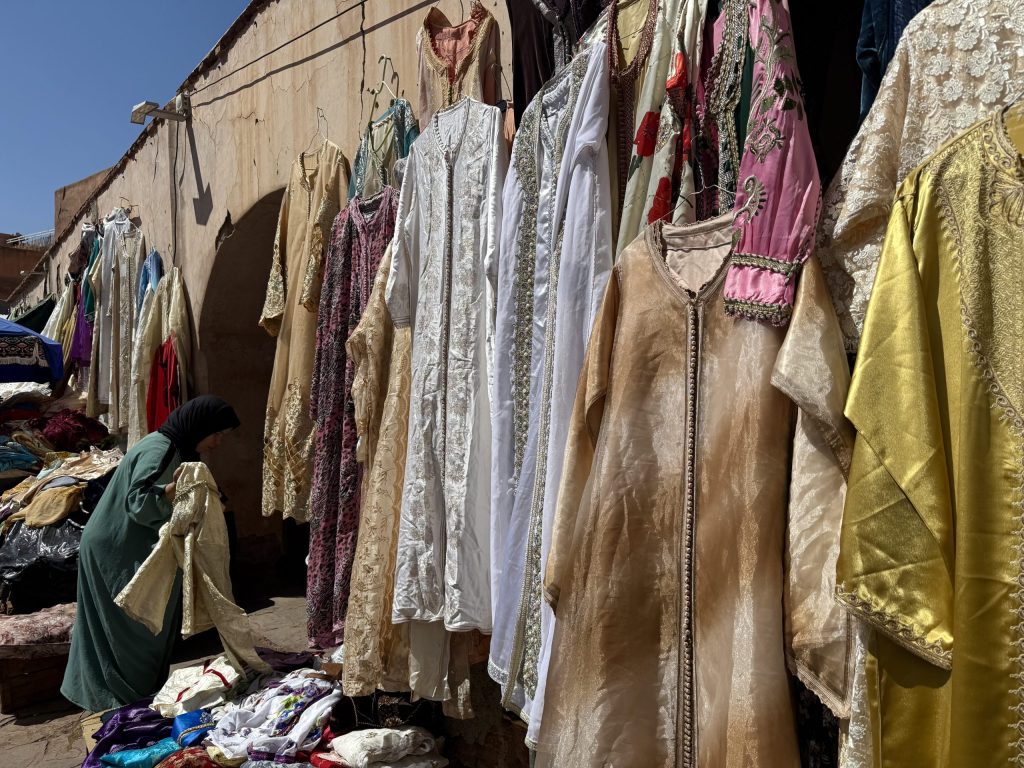
Where to Shop – Amina’s Favorites
When shopping, try to buy directly from artisans or co-ops rather than mass-produced stalls. There are so many artisans and designers around crafting wonderful pieces that you can purchase. This way, you money goes straight to helping the local economy and preserving local craftsmanship. Here some of my favorite clothing and accessory shops in Morocco:
Marrakesh:
Chabi Chic: An ethical Moroccan brand that promotes and elevates Moroccan craftsmanship. They carry Moroccan-inspired jewelry, among other beautiful pottery and decoration items. They sell online and also have several shops around the city and medina. Check the location of their stores on their website.
Hanout Boutique: A very cute indie designer shop with a modernized Moroccan vibe. You’re in for a treat when it comes to dresses, tunics and caftans. They come in all styles and shapes. All unique, handmade by local artisans, and with a chic minimalist Moroccan touch. They have 2 Medina shops, one at 15 Rue Riad Zitoun el Jdid and another one on 90 Route Sidi Abdelaziz.
Souk L’ghzal: In the heart of Marrakech Medina, right off Place des Epices, is a traditional wool market where artisans wash, spin, and dye wool by hand. It also features an area where women sell second-hand caftans, some of which are charming vintage pieces.
Raffia shoe shops: These are scattered around the Medina. Ideally you go to a shoemaker and pick your favorite. If you can’t find it, they can generally custom-make something special for you within a couple of days. Check out a small shop at the southern end of Rue Riad Zitoun Jdid.
Tangier:
Las Chicas concept store right outside of the Kasbah Gate and Kasbah Collective a few steps up from Las Chicas on the same block. They carry designer clothes, bags, accessories, decoration items and a few more things hand-made locally.
Chefchaouen:
The Hat Man is one of my favorite places to shop. This funky shop is located toward the top of the medina on the main thoroughfare, Rue Targui on your way uphill from the main square. Hand knitted hats are available in many shapes, sizes and various levels of ridiculousness. There is a sign that reads “Hat Man.” You can’t miss it.
Address: Rue Targui, Chefchaouen Medina
Essaouira:
Another raffia shoemaker and designer – Abdellah. He’s great and has some beautiful designs that mix between modern and traditional styles. Abdellah makes beautiful and comfy shoes, purses, bags and other accessories made out of raffia, a natural fiber sourced mainly from Madagascar palm tree leaves. His creations are customizable in color, size and style. If you’re looking for a pair of breathable summer footware, you will find a large selection in his shop: mocassins, sandals, derbies, Moroccan-style slippers and much more.
Address: Rue Abdelaziz Fachtali (sawaraj), Essaouira
Online:
Rita Creations: This is a Moroccan designer jewelry brand, blending heritage and modernity into minimalist silver designs. Handmade in Rabat, using silver 925, the pieces celebrate craftsmanship, durability, and timeless style. They draw their inspiration from traditional Berber tattoos, Arabic calligraphy and Moroccan geometric shapes. You can get an appointment if you want to visit Rhita’s showroom and workshop in Rabat. You can also find Rhita Creations accessories for sale in different indie stores in Casablanca, Marrakesh and Tangier.

What I have given you here is not an exhaustive list. We all have our preferences and individual styles. But I hope it will provide you with some helpful tips. The Moon Marrakesh & Beyond guidebook has a wonderful shopping guide for Marrakesh if you want some more addresses for when you’re on the ground! Not only that, but with guidebooks like Moon Morocco by Lucas Peters, you’ll definitely get a deeper insight into the culture.
As you travel around Morocco, you will notice that women dress in a variety of styles —from headscarves and traditional jellabas (ankle-long robes with a hood), to skinny jeans, dresses, crop tops and shorts, especially in coastal towns during summer. Remember that tourist hubs like Marrakesh and surf towns like Imessouane are generally more relaxed about showing skin than smaller towns in the countryside.
You don’t need to dress conservatively by Western standards, but showing cultural awareness is part of respectful and sustainable travel. Moroccan women are masters at blending tradition with fashion. I think if you pack with that same spirit while staying true to your own style, you’ll feel comfortable and will naturally fit into our vibrant culture.
My tip: When packing for your next Morocco trip, think 3 C’s: comfort, climate and customs!
About the Author

Amina Lahbabi is a proud Moroccan, feminist, mother, climate change activist, and promoter of education, equal rights and freedom of expression. She is at the forefront of all of Journey Beyond Travel’s NGO initiatives. She loves art, freedom of expression, and is an accomplished photographer in her own right. She holds multiple graduate degrees in translation and communication and was a Fulbright Scholar at Michigan State University. She also obsesses about her wardrobe from time to time and how to make it more eco-friendly. She lives in Tangier. You can check out her Wikipedia.

